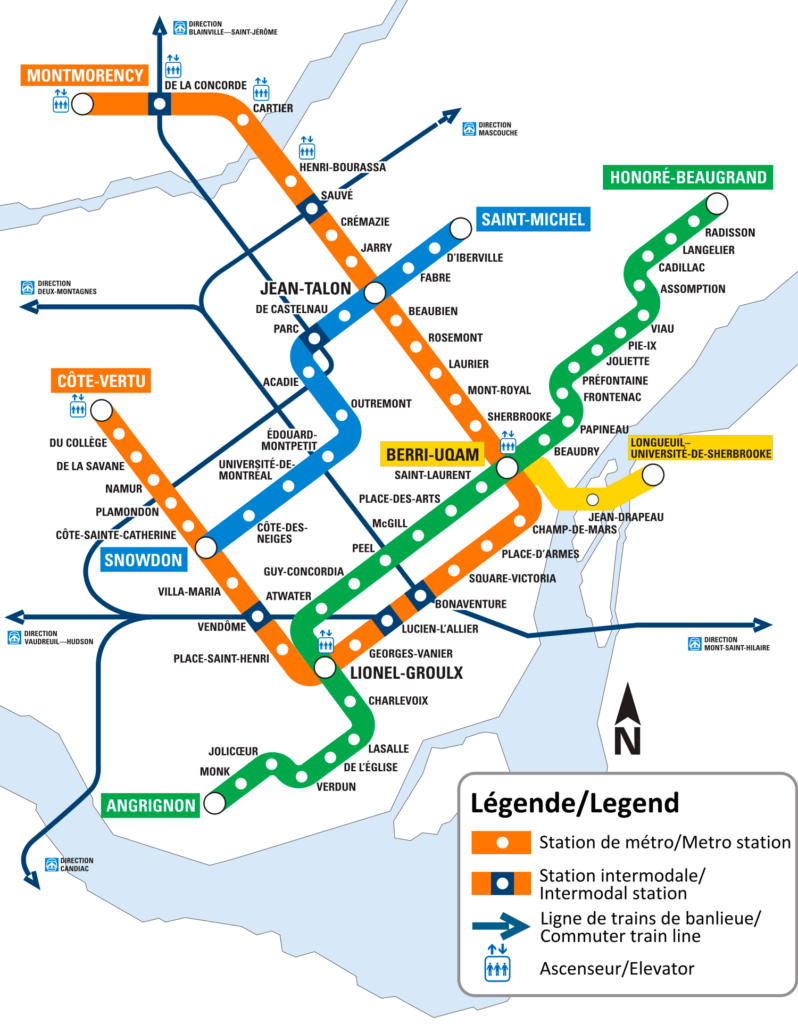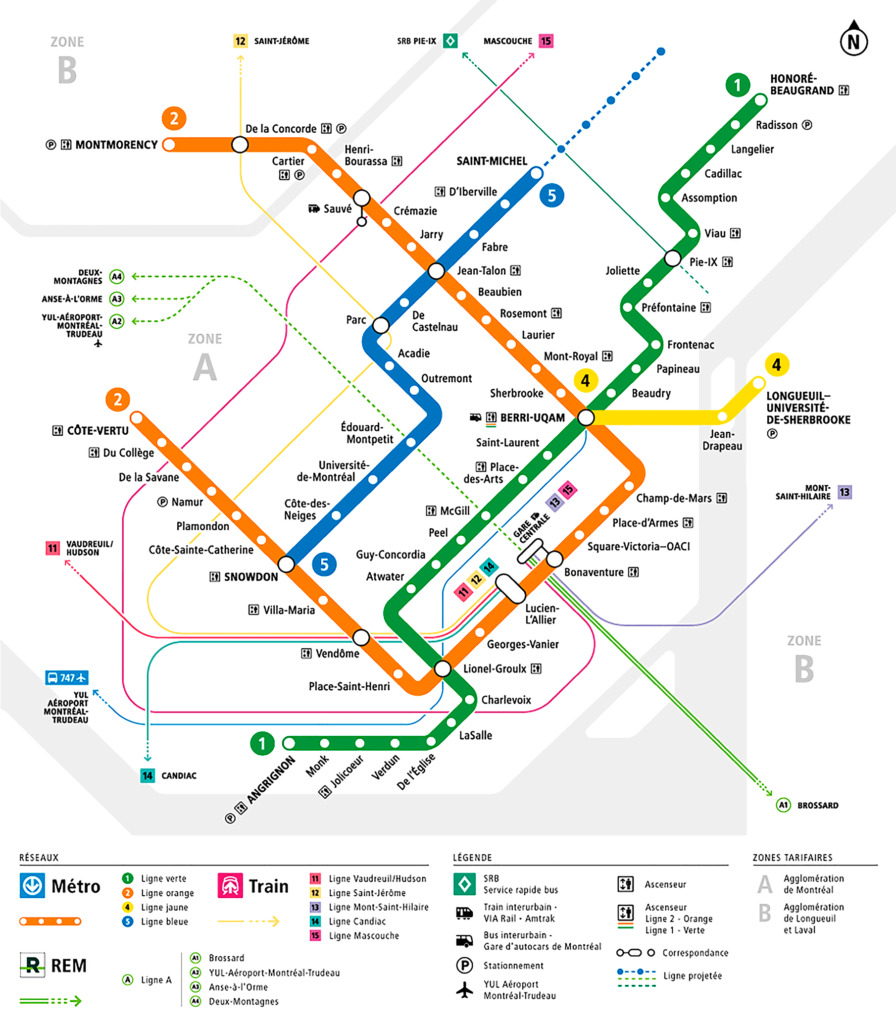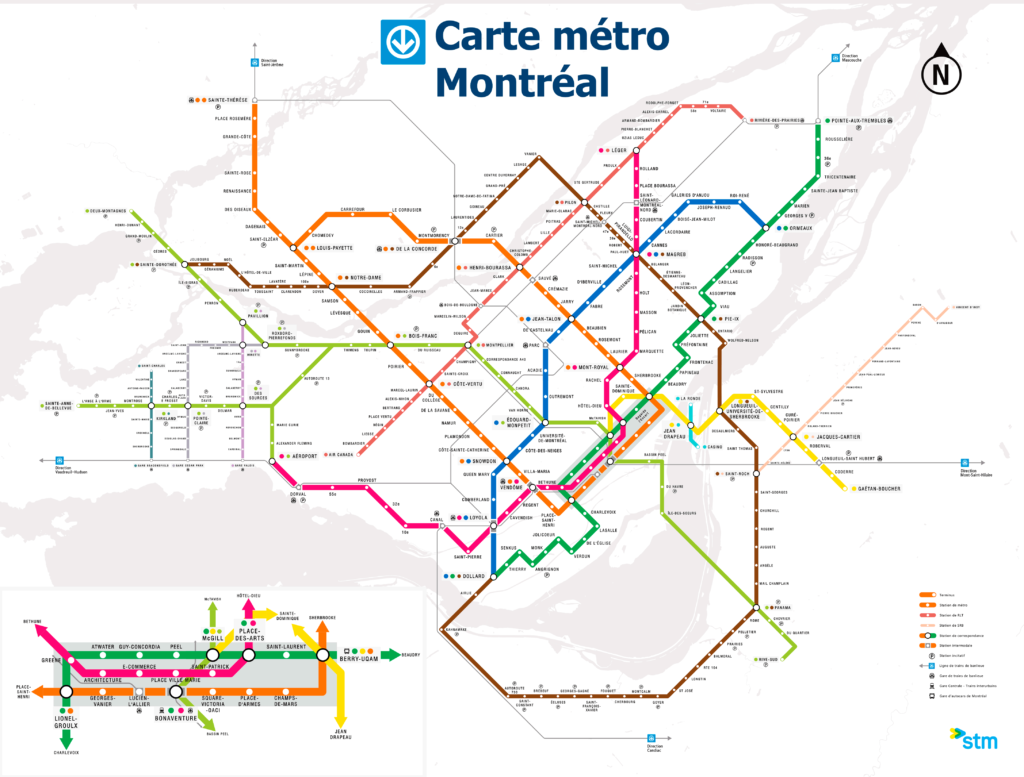Montreal subway, officially known as Métro de Montréal, is an underground rapid transit system that operates in the city of Montreal, Quebec, Canada.
It was inaugurated on 14 October 1966 during the mayor's term Jean Drapeau. Since its opening, has grown from 22 stations on two lines 68 stations on four lines, with a total length of 69,2 kilometres (43 miles).
The Montreal Metro is the busiest rapid transit system in Canada, with an average of 1,046,300 daily trips on weekdays and an annual total of 303,969,500 trips in 2023.
subway map
Below we show you the Montreal metro map in various versions, click on the map to enlarge the image.



Montreal subway schedules
- Work days: from 5:30 AM until 1:00 AM
- Saturdays: from 5:30 AM until 1:30 AM
- Sundays and holidays: from 5:30 AM until 1:00 AM
Rates
Below are the main rates, with its equivalent in US dollars:
- Single ticket: 3.50 CAD (2.58 USD)
- 2 trips: 7.00 CAD (5.16 USD)
- 10 trips: 29.50 CAD (21.75 USD)
- daily ticket: 11.00 CAD (8.11 USD)
- Unlimited weekend: 15.25 CAD (11.24 USD)
- weekly card: 29.00 CAD (21.38 USD)
- monthly card: 94.00 CAD (69.29 USD)
- annual card: 1128.00 CAD (831.50 USD)
Official Web site
- This is the official website of the Montreal metro.
- This is the website with all the attractions of montreal.
History of the Montreal subway
The Montreal subway opened on 14 October 1966. The idea of building a subway in Montreal arose due to increasing congestion on the streets..
Beginnings and construction
The metro project began to seriously take shape in 1960 when Jean Drapeau, mayor of Montreal, was convinced by his collaborator Lucien Saulnier during a trip to Paris. There they observed the technology of trains with rubber tires, which offered quieter operation and faster acceleration. Inspired by this innovation, Drapeau y Saulnier promoted the construction of the Montreal subway with this unique technology in North America.
In January 1961, The Quebec government granted the city of Montreal the power to build the subway, and official planning began in April of that year. Construction began on 23 May 1962, employing more than 5,000 workers at their peak. The final cost of the project was $213.7 million dollars.
Expansion phases and opening of lines
The original subway consisted of two lines: the Green Line and the Orange Line, inaugurated in 1966. The Green Line, that runs east-west, connected Atwater and Papineau stations, while the Orange Line, that corre norte-sur, iba of Henri-Bourassa in Bonaventure.
In 1967, The Yellow Line was added to serve the Expo 67, connecting downtown Montreal with Longueuil. Construction of the Blue Line began in 1986, and was completed in 1988, extending the system to the northeast of the city.
Engineers and construction companies
The design and construction of the metro was carried out by several prominent engineers and architects. The main engineer was Lucien L’Allier, who was also the director of Public Works. The First Train Units, known as MR-63, were manufactured by Canadian Vickers, a company that was later acquired by Bombardier.
Development and unique features
The Montreal Metro is recognized for its distinctive architecture and public art. Each station was designed by a different architect, which gives a unique identity to each one. Besides, has more than 100 public works of art, including murals and stained glass, that adorn the seasons.
One of the most interesting aspects is the use of rubber tires instead of steel wheels, providing a smoother ride and reducing noise. This innovative design has been a distinctive feature of the Montreal subway since its inauguration..
The Montreal metro has evolved from its humble beginnings in 1966 to become one of the largest rapid transit systems in North America, combining transportation efficiency with a rich cultural and artistic heritage.
History of the Montreal Subway Map
First designs and implementation
The Montreal metro map has evolved significantly since the metro's inauguration on 14 October 1966.
Metro planning (and your map) began at the beginning of the decade 1960 under the direction of the mayor Jean Drapeau and his collaborator Lucien Saulnier. The first network consisted of two lines: the Green Line and the Orange Line, that covered the main axes of the city.
Development and expansions
On the first years, the original map design was simple, due to fewer stations.
Over time, as the subway expanded, the map was adjusted to include new lines and stations. The Yellow Line was added in 1967 to serve the Expo 67, connecting Montreal with Longueuil. Posteriorly, in 1988, The Blue Line was inaugurated, further expanding the network.
Designers and companies involved
The engineers and planners of the Société de transport de Montréal (STM) influenced the initial design of the map, overseeing the construction and expansion of the subway.
Lucien L’Allier, One of the leading engineers, played a crucial role in the planning and development of the subway system and map. The company Canadian Vickers, which was later acquired by Bombardier, manufactured the first trains MR-63.
Modern Changes & Updates
The current Montreal metro map has undergone several updates to reflect expansions and improve its clarity.
The Société de transport de Montréal (STM) has worked with various graphic designers and companies specialized in cartography to create updated versions of the map.
Recently, the STM collaborated with the company “Axonometric” to redesign the map, incorporating elements such as the new Réseau express métropolitain (REM) and bus rapid transit corridors, ensuring an accurate and easy-to-understand representation for users.
Additional data
The Montreal Metro stands out for its distinctive architecture and public art. Several different architects designed each station, giving them all a unique character. Besides, The system has more than 100 public works of art, including stained glass, murals and sculptures by Quebec artists.
This meter is unique in North America to use rubber tires instead of steel wheels, providing a smoother ride and lower noise. The current network mainly serves the north, East and Central Isle of Montreal, with connections to Longueuil through the Yellow Line and Laval via the Orange Line.
The subway is not only an efficient means of transport, but also a cultural and architectural attraction, highlighting stations like Champ-de-Mars, featuring an impressive stained glass window by the artist Marcelle Ferron.
Below is a list of the most important and visited attractions in Montreal:
- Notre-Dame Basilica (Place-d’Armes, Orange Line): Impressive Gothic church known for its splendid interior and luminous display of lights and sounds.
- park Mont-Royal (Mont-Royal, Orange Line): A vast green space designed by Frederick Law Olmsted, perfect for walks and panoramic views.
- Montreal Museum of Fine Arts (Guy-Concordia, Green Line): Important art museum with a diverse collection of works from antiquity to contemporary art.
- Vieux-Port from Montreal (Champ-de-Mars, Orange Line): Historic riverside area with activities, festivals and boat trips.
- Montreal Botanical Garden (Pie-IX, Green Line): Extensive garden with an impressive variety of plants and themed displays.
- Biodome de Montreal (Viau, Green Line): Interactive space that simulates diverse ecosystems of the Americas.
- Parc Jean-Drapeau (Jean-Drapeau, Yellow line): Island complex with event facilities, amusement parks and recreational areas.
